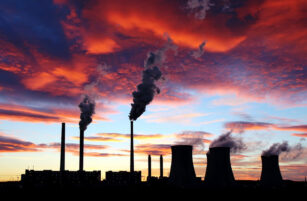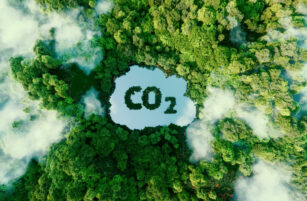Insight Focus
- Power sector emissions dropped 24% amid sharp growth in renewables
- Industrial emissions fell 7%
- Decline was more than expected, may lead to renewed EUA price weakness
Verified emissions from more than 12,000 industrial and power installations covered by the EU’s Emissions Trading System fell by almost 16% in 2023, the biggest annual decline in greenhouse gases since the market launched in 2005.
The data showed a slightly larger decline than had been expected by most expert analysts, who had foreseen a fall of around 14%.
Analysts at LSEG calculated that preliminary data submitted to the EU showed total emissions of 1.08 billion tonnes last year, compared to a 2005 total of just over 2 billion tonnes – a reduction of around 47%.
Emissions from the electricity generating sector dropped the most, falling nearly 25% from the year before. Data from the EU’s grid operators agency ENTSO-E show that power output from plants using natural gas, hard coal and lignite fell by 21% in 2023, while renewable generation grew by almost 10%.
Industrial plants saw emissions drop by 53 million tonnes or 8.6% to 571 million tonnes, LSEG analysts said, as manufacturing struggled to recover amid persistent high energy costs and a gloomy macroeconomic outlook.
Within the industrial segment of the market, LSEG said emissions from chemical plants were down 9% while metals producers reported a 9.5% decline.
The data failed to generate much of a surprise in the market, with most participants well aware of the sizeable drop in power-sector emissions due to the regular publication of generation data. But some experts were at pains to stress last week that fossil energy’s weakening performance will continue in 2024.
Data from ENTSO-E show that power generation from fossil-based sources dropped by 18% year-on-year during the first quarter of this year, as the winter weather was mild and renewable capacity continues to grow.
Consultancy Rystad Energy estimated that wind power output will grow by 38 terawatt-hours in 2024, or around 10%, while solar production could jump by as much as 50 TWh, or 25%.
The drop in fossil output has created a large problem for the EU ETS, where the power sector still accounts for around half the total demand for EUAs.
Power plants must buy all the allowances they need from the market or at daily auctions. In 2023 the EU sold 517 million EUAs at auction, and LSEG estimated power plants used only 507 million for compliance last year.
(Industrial plants are given free EUAs representing a large share of their total emissions as protection against carbon leakage.)
To that modest surplus of 10 million EUAs must be added an additional 35 million that were injected into the market under the REPowerEU programme. Another 70 million at least are being added to supply this year, further weighing down the market.
As we highlighted in last week’s column, investment funds were quick to spot the declining trend in EUA demand last year, and built up substantial net short futures positions starting from last August. The big drop in emissions last year will have only reinforced their conviction that the market remains substantially oversupplied in the short term.
Some analysts have reiterated their view that EUA prices, which are currently just over €60, may still test €50 and even lower before the current quarter is over.
The second half of 2024 may see a revival in demand, however. The annual compliance deadline falls at the end of September and may trigger some buying. In addition, low prices may encourage companies to buy in advance for compliance in 2024 and later.
And with financial analysts continuing to bet that central banks will start to lower interest rates from the summer, the outlook for industrial demand is expected to improve in the second half of the year.
On the supply side, the annual adjustment in auction volumes by the market stability reserve will be announced in the next month, and it’s likely to show an increase from the 272 million EUAs that were withdrawn from the auction programme in the year ending August 2024.













